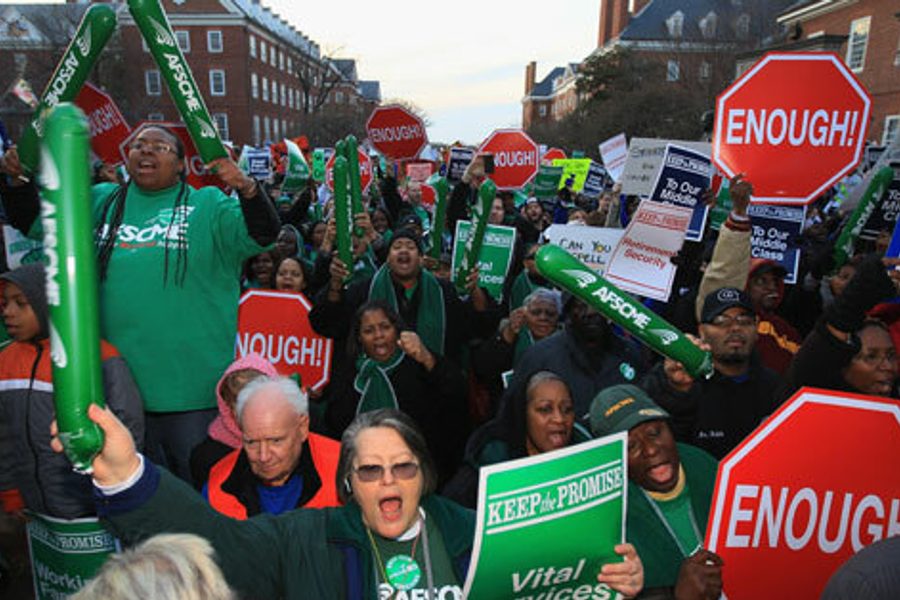Michigan? Ohio? Indiana? In the wake of Republican Governor Scott Walker’s over-the-top attacks on public sector workers in Wisconsin, many people are asking which will be the next state to draw the public spotlight. However, looking at the state-level assaults by these arch-conservatives as individual battles might be the wrong approach. Ultimately, the right-wing maneuvers at the state level are part of a closely coordinated strategy. And together they add up to a national story.
The right-wing’s strategy is to blame complex economic problems on one of three scapegoats: teachers, immigrants, or government employees. The tactic of scapegoating consistently reappears throughout the history of politics for a reason. It offers politicians an easy way out. Instead of having to come up with real substance for their political agendas, they can tell a simple story with a simple villain. At a time when the country is in grave distress, they can pick out a select group and blame all of our problems on them.
While this strategy has become popular in many Republican statehouses, it is more ridiculous today than ever. The economic problems we face are complex ones. We live in a global economy, where national boundaries that previously shielded our industries have been eliminated and markets are affected by economic decisions made throughout the world. Yet, amid this complexity, conservative leaders insist that things are plain: teachers, immigrants, and government employees are at fault for our woes.
Hiding behind this absurd premise, the right-wing has launched a sneak attack. They are attempting to rush through different statehouses a set of laws that have nothing to do with creating jobs or strengthening the economy. Rather, the laws are about undermining the ability of groups to organize collectively and exercise political influence at the polls.
Teachers and government employees, in particular, have been selected because they are some of the last organized voices that oppose an unchecked corporate agenda. They have been strategically targeted because they represent the last vestiges of middle-class America.
From a distance, the types of measures being pursued in different states look diverse and varied. But if you examine them, these conservative initiatives fall into three basic categories. This three-pronged attack represents a national strategy, and it is what makes the state-level attacks a truly national story.
First, under the guise of targeting “lazy” and “overpaid” teachers, conservatives are working to dismantle public education. Eliminating the rights of teachers to bargain collectively and have a say in their schools, as in Wisconsin, is a first step toward this end, a means of clearing the way of organized opposition to privatization.
The effort in Florida to end teacher tenure is part of this same process, as is the pending legislation in Pennsylvania that would create a voucher program that would draw even more resources from public education. Furthermore, such moves go hand-in-hand with budget austerity for public schools. We see this in many states – including Kansas, where Republican Governor Sam Brownback is slashing this year’s funding for schools by over $50 million.
Second, in the name of balancing state budgets, conservatives are seeking to undermine public sector’s role in providing essential social services. Part of a decades-long drive to “starve the beast” of government, they are using attacks on public employees in a drive to hand over public activities to private corporations, which can then run them as means of generating profit.
John Kasich, the Republican governor of Ohio, is pursuing a budget that would sell state prisons and lease the state turnpike to private interests. Similarly, a bill in Michigan would privatize support services to public schools. And the Georgia State Senate is pushing to create a committee that would review all state agencies with an eye to possible privatization. In each case, organized workers are disempowered in the political realm and corporations strengthened.
Finally, conservatives seek to block the voice of immigrants in American politics. Despite a total absence of evidence that non-citizens have voted illegally in this country, New Hampshire Republicans are advancing a “Voter I.D.” bill. This would create new barriers to voting and discourage people not yet registered from exercising their legal rights. Unfortunately, that state is not alone. Similar efforts are underway in Colorado, Kansas, Massachusetts, Missouri, and Tennessee, among others.
Each of the three prongs of the Republican attack is crafted to target a chosen scapegoat. But none of them do anything to address the real economic problems facing Americans.
That these proposals lack any substance in terms of solving public problems is plenty appalling by itself. But making it even worse is the deafening silence from the other side — silence from the politicians and other public leaders who should be speaking out most forcefully against the scapegoating. The political landscape is bleak. One side has drastically oversimplified the difficulties we face in order to push through a disingenuous agenda. The other side can’t seem to come up with anything to say in response.
Therefore, it’s up to us. All of us who are concerned, disgusted, outraged, and revolted must step up. Grassroots campaigns have sprung up across the country, from “Stand Up Ohio” to “Not My Wisconsin.” You can join these campaigns at the local level or get involved with national campaigns like “We Are One,” which is sponsoring a national day of action on April 4.
No matter which group the attackers try to scapegoat in a given state, or how they try to disguise their true agenda, we cannot allow the evisceration of the common good in our country to continue.
Amy Dean is co-author, with David Reynolds, of A New New Deal: How Regional Activism Will Reshape the American Labor Movement. She worked for nearly two decades in the labor movement and now works to develop new and innovative organizing strategies for social change organizations in progressive, labor, and faith communities. You can follow Amy on Twitter at @amybdean, or she can be reached via the Web site, www.amybdean.com.









